Seagate Barracuda XT 2TB: SATA 6Gb/s Performance Preview
by Gary Key on October 29, 2009 12:00 AM EST- Posted in
- Storage
AnandTech Small Folder Transfer Results –
In our first storage test, we utilize a 3.82GB test folder and transfer it from our WD VelociRaptor drive to the competing hard drives.

There is only a 2% difference in performance between the two drives on the Intel P55 controller and basically a tie on the Marvell controller. We did not expect anything really different as the average sustained transfer rates between all three drives are very close.
In our second storage test, we utilize the same 3.82GB test folder and transfer it from our test hard drives to the Intel 160GB SSD.
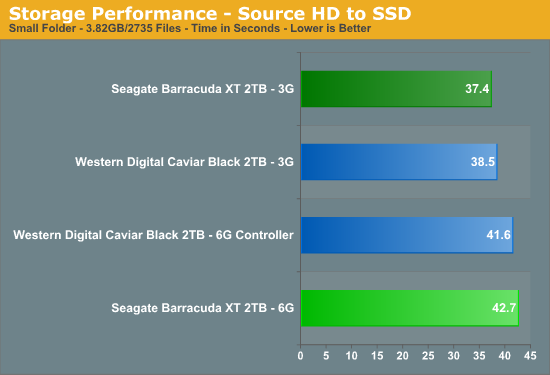
The tables flip here with the Seagate drive performing about 3% faster on the Intel controller than the WD drive. However, Seagate drive is 12% faster in this test on the Intel P55 in 3Gb/s mode than at 6Gb/s mode on the Marvell controller.
In our final small folder test, we utilize the 3.82GB test folder and transfer it from our test SSD back to the competing hard drives.

We finally see the Marvell 9128 chipset making a difference. The Seagate XT drive is 9% faster in 6Gb/s operation than in 3Gb/s mode on the Intel P55. We noticed peak transfer rates of 296MB/s on the Marvell controller compared to 262MB/s on the Intel controller with the Seagate drive. In both cases, the Seagate drive is faster in this test than the Western Digital drive.
AnandTech Large Folder Transfer Results –
In our first storage test, we utilize a 15.2GB test folder and transfer it from our WD VelociRaptor drive to the competing hard drives.
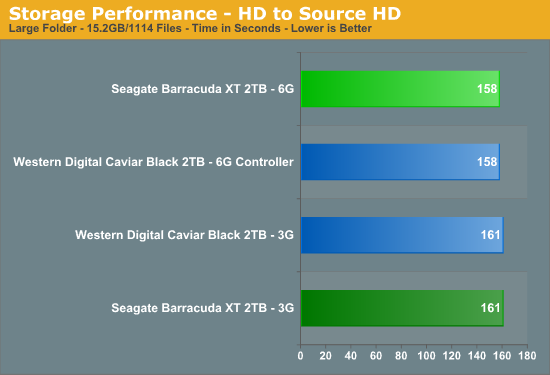
Our two drives perform identically on like controllers, the only difference here is that the Marvell controller is leading Intel in part to the aggressive 1027 driver algorithms that utilize additional system memory for transfer caching.
In our second storage test, we utilize the same 15.2GB test folder and transfer it from our test hard drives to the Intel 160GB SSD.
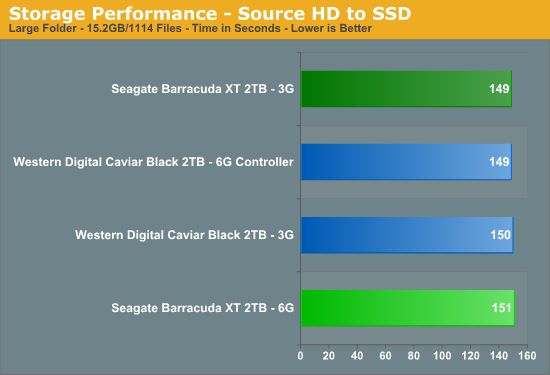
Interestingly enough, the WD drive is faster on the Marvell controller than the Intel. However, the Seagate drive benefits from the Intel controller.
In our final large folder transfer test, we utilize the 15.2GB folder and transfer it from our test SSD back to the competing hard drives.
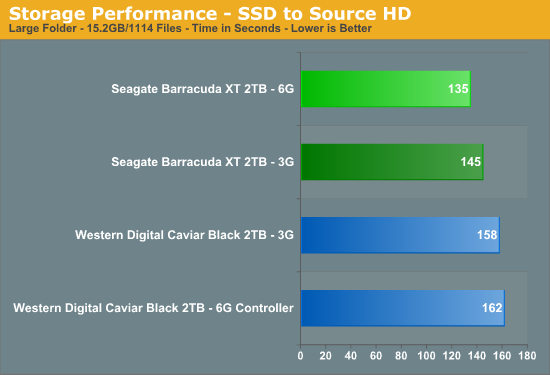
Like our small folder test, we see the benefits of the Marvell Controller in SATA 6Gb/s mode as the Seagate drive is 7% faster than it is in SATA 3Gb/s operation. The WD drive is up to 17% slower in this particular test.
PCMark Vantage x64 Results –
We are showing the total score for the PCMark Vantage disk benchmark as a reference point between the two controllers and drives.
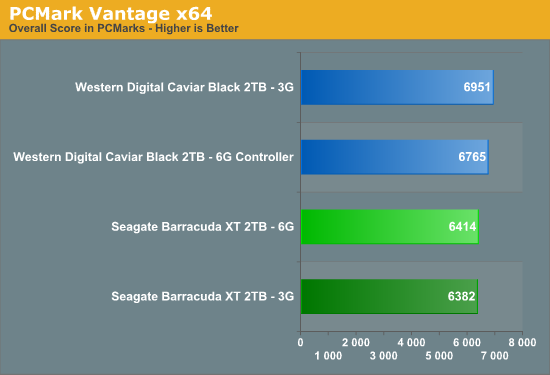
The Seagate XT drive in SATA 6Gb/s mode on the Marvell controller is barely faster than SATA 3Gb/s mode on the Intel controller. The WD drive is just flat out faster in this particular benchmark with the Intel controller being about 3% faster than the Marvell controller.
Quick Thoughts:
That was a letdown in several ways. We never really expected that much out of SATA 6Gb/s technology as our two hard drive samples are just now pushing the boundaries of SATA 1.5Gb/s. Only when we utilized a fast SSD as the source drive to copy files to the Seagate Barracuda XT did we see an advantage in the burst rates available on it and the Marvell 9123 chipset. Even then, the advantage was fleeting as the sustained transfer rates equalized quickly between the two controllers. This test is just the opposite of what a typical user would perform anyway as most would utilize the hard drive for storage purposes and not the SSD.
Even more disturbing was the performance disparity between the Seagate Barracuda XT 2TB and the Western Digital Caviar Black 2TB drive in our limited benchmark test suite. We expected more from the Seagate drive based on its specifications, not the 6Gb/s abilities but platter design and cache setups. Hopefully Seagate can improve performance with firmware changes, if not; the battle is already lost regardless of controller technology.
We just do not see SATA 6Gb/s technology offering any real benefits for spindle-based hard drives on the desktop at this time. Rotational speeds are being kept in check at 7,200rpm with all the performance improvements coming from increased areal densities and cache. We expect SATA 6Gb/s to really come into its own with solid state drives. This will not occur quickly but we expect to see recognizable benefits with controller designs about two generations ahead of where we are currently. By that time, both AMD and Intel will have native 6Gb/s capabilities on their controller hubs.
In the meantime, we see the current implementations of 6Gb/s technology on motherboards as being a marketing checklist feature for the most part. However, since the Marvell 9123 chipset can fall back to SATA 3Gb/s or 1.5Gb/s operational mode it does offer additional SATA ports on the motherboard with performance that is fine for secondary storage devices.










55 Comments
View All Comments
ipay - Monday, November 2, 2009 - link
Buying or making a custom cable is the exact opposite of "easy" for people who expected the drive to work as advertised.SpatulaCity - Friday, October 30, 2009 - link
I always thought there were 8 bits in a byte.6Gbps / 8 = 750MBps
am I confused or missing something?
peldor - Friday, October 30, 2009 - link
8/10 encoding.http://en.wikipedia.org/wiki/10/8_encoding">http://en.wikipedia.org/wiki/10/8_encoding
coyote2 - Thursday, October 29, 2009 - link
I'd love to see how the (budget) Hitachi 7200rpm compares to the WD Caviar Black and this Seagate XT. thanks AnandTech!dragunover - Thursday, October 29, 2009 - link
Reviews around the net show this is a great performer. Why not test more hard-drives like this one?Robear - Thursday, October 29, 2009 - link
I really like the "less synthetic" IO benches, with the file transfers and all.Standardized benchmarks are a double-edged sword. On the one hand the standardized benchmark can be reproduced and hence verified, attributing to the credibility. On the other hand, firmware can be tweaked to the benchmarks to skew benchmarks and obscure actual performance.
I'd like to see a mix of standardized and non-standardized (i.e. "Anandtech Benches") more in the future.
I'd like to see real-world scenarios, like game install times, game load times, software builds, anti-virus scanning, etc.
MadMan007 - Thursday, October 29, 2009 - link
So SATA 6Gb/s implemented by an add-on chip will do little but add cost? Great :/motigez - Thursday, October 29, 2009 - link
well done for the Storage Bench, to my opinion, this is the only test which should matter to the end user, I would strongly recommend to keep it simple, no heavy and light, only one combination, and find some way to normalize it in comparison to SSD, this would finally allow users to tell which drives are better for them, which makes a difference and worth the premium, there is nothing we can do with pure sequential numbers...and base on my experience PcMark does not tell enough about user experience,Thanks AnandTech
MrSpadge - Thursday, October 29, 2009 - link
There are 2 things to take away from this:1. SATA 3 doesn't change anything for current HDDs. That's just as expected, because they'd have done something wrong if the current SATA 2 interface would already have been a limit. The push to higher performance interfaces always preceded their need - and that's good, but nothing to get excited about (either positive or negative).
2. Seagate's performance is.. "mixed", if I choose the most euphemistic words. That's been the case since many years and I still don't understand why people would like them.
chizow - Thursday, October 29, 2009 - link
As I stated a few months ago when news of this 2TB drive broke, SATA 6.0 is hardly needed on mechanical drives as they're not even fully utilizing SATA 3.0, only a slight benefit from peak rates as this bench shows.Its quite clear the Marvell controller is also bottlenecked by these mechanical drives and overall less efficient than the Intel controller. The HD to HD transfers show the mechanical drives are typically the bottleneck, but the Intel drives write speeds are also bottlenecks in the HD to SSD benches. The only scenario the mechanical drives aren't bottlenecked is in the SSD to HD test where the high SSD reads allow for the higher mechanical drive transfers.
I would've liked to have seen HD to SSD transfer results with an SSD with faster sustained write speeds, like one of the Indilinx drives that get ~200MB/s writes. I would've also liked to have seen all SSDs tested on one of these SATA 6.0 controllers to truly isolate its performance compared to SATA 3.0. I understand its beyond the scope of this review, it just seems like neither the controller nor the drive are up to the task of achieving potential performance.